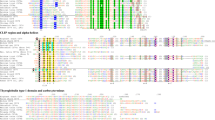Abstract.
The emergence in Camelidae species of functional antibodies devoid of light chains (referred to as heavy-chain antibodies or HCAbs) is an intriguing evolutionary event. Homodimeric HCAbs have also been documented in spotted ratfish (Cos5-Abs) and nurse shark (NAR). To reveal the evolutionary history of HCAbs, we evaluated the phylogenetic and phenotypic relationships among HCAbs and conventional antibodies across taxa and confirmed the current viewpoint that different groups of HCAbs have evolved independently in the three lineages. At least, in the camelids, HCAbs are not the result of resuscitation of dormant genes. They are derived from the conventional antibodies within the Camelidae lineage, and are apparently the outcome of more recent adaptive changes occurring in the compartment of heteromeric antibodies. The shared structural properties of HCAbs across taxa are therefore explained by convergent evolution due to similar constraints related to the absence of pairing to the light chain. It appears that innovative evolutionary changes in Camelidae have led to a new level of antigen binding repertoire diversification and have allowed acquisition of novel antigen-receptor properties.
Similar content being viewed by others
Author information
Authors and Affiliations
Additional information
Electronic Publication
Rights and permissions
About this article
Cite this article
Nguyen, V., Su, C., Muyldermans, S. et al. Heavy-chain antibodies in Camelidae; a case of evolutionary innovation. Immunogenetics 54, 39–47 (2002). https://doi.org/10.1007/s00251-002-0433-0
Received:
Revised:
Issue Date:
DOI: https://doi.org/10.1007/s00251-002-0433-0




